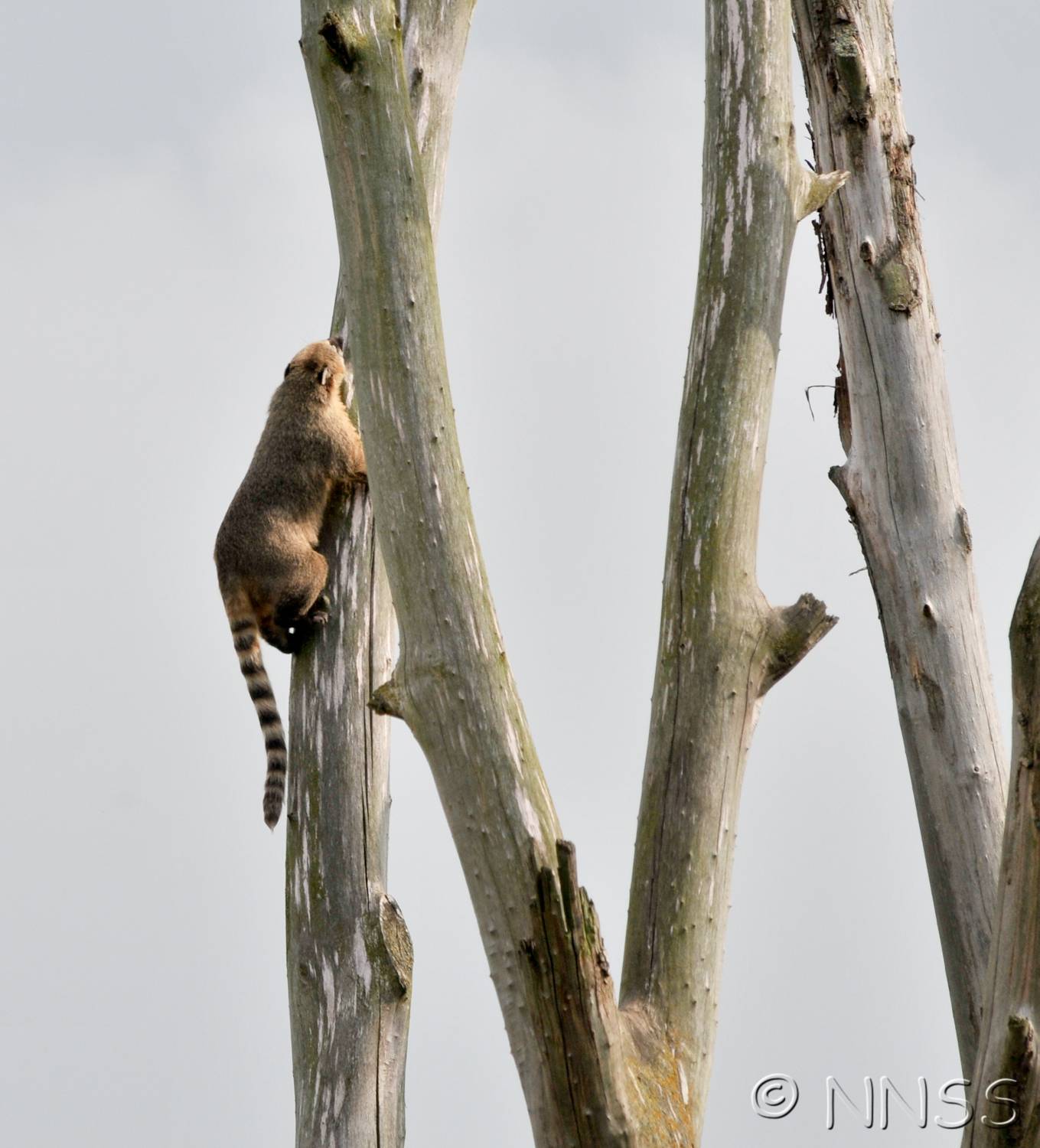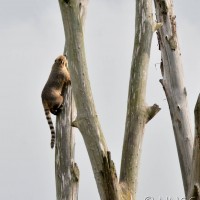
Coati - Nasua nasua
Expand and collapse the sections below by clicking on the title or + / - icons.
Short description of Nasua nasua, Coati
The South American coati resembles its close relative the raccoon Procyon lotor of North and Central America in size and general appearance. Its fur is a pale brown, often reddish, with darker legs, feet, ears and markings around the face and long, pointed snout. The tail is thick and bushy, strongly ringed with darker brown, and often held aloft. The animals are active diurnally, hunting for fruit or for animal prey on the ground or high in trees.
Impact summary: Nasua nasua, Coati
No impacts are known of coatis as non-native animals but might possibly be similar, were they to be introduced, to those of raccoons in continental Europe.
Habitat summary: Nasua nasua, Coati
A variety of wooded landscapes are inhabited by South American coatis, including gallery forest, cerrado (tropical and woodland savannah) and wetlands. Forests are generally preferred and open areas used more sporadically.
Overview table
| Environment | Terrestrial |
|---|---|
| Species status | Non-Native |
| Native range | Mexico, Central America, Brazil, Argentina Distrito Federal, Bolivia, Colombia, Ecuador, French Guiana, Guyana, Peru, Paraguay, Surinam, Uruguay, Venezuela |
| Functional type | Omnivore |
| Status in England | Non-Native |
| Status in Scotland | Non-Native |
| Status in Wales | Non-Native |
| Location of first record | ? |
| Date of first record | Unknown |
Origin
The South American coati has a wide native distribution east of the Andean chain, from Colombia and Venezuela southwards to northern Argentina and northern Uruguay.
First Record
Sightings in south Cumbria in 2003–04 may have been the first in the wild in GB.
Pathway and Method
The South American coati is a popular subject for zoological collections and is relatively skilled at escaping from captivity. Short-term escapes from captivity have been the pathway for the records so far in GB.
Species Status
The South American coati is widespread and common across most of its native range and is classified as of 'Least Concern' for conservation by IUCN. The only known non-native population is on Robinson Crusoe Island in the Juan Fernandez Islands in the southeast Pacific Ocean (Chile).
Dispersal Mechanisms
These animals can travel long distances on feeding forays and can climb and swim well. Young males disperse from their natal group when about three years of age.
Reproduction
Adult males are generally solitary whereas females and young animals, including males up to two years old, live in groups. Females in a group all come into oestrus at once, when fruit is in season. Pregnant females leave the group temporarily to give birth and suckle their young in a nest built in a tree.
Known Predators/Herbivores
South American coatis are prey in their native range to foxes, jaguars, pumas, ocelots and jaguarundis, and to dogs and people.
Resistant Stages
None known.
Habitat Occupied in GB
The few animals observed in GB have mostly been in the vicinity of the zoological collections that were presumably their source.
There were seven known records in GB up to 2008, involving ten animals. During 2003–07, perhaps up to ten animals were recorded in the wild in south Cumbria.
Environmental Impact
No ecosystem impacts are known but an established non-native population might become an important predator of or competitor with native wildlife.
Health and Social Impact
None are known.
Economic Impact
None are known.
Identification
Wilson, D.E. & Mittelmeier, R.A. (eds) (2009) Handbook of the Mammals of the World. Volume 1: Carnivores. Lynx Edicions, Barcelona.
Biology, ecology, spread, vectors
Beisiegel, B.M. & Mantovani, W. (2006) Habitat use, home range and foraging preferences of the coati Nasua nasua in a pluvial tropical Atlantic forest area. Journal of Zoology, 269, 77–87.
Gompper, M.E. & Decker, D.M. (1998) Nasua nasua. Mammalian Species, 580, 1–9.
Guilherme Trovati, R., Alves de Brito, B. & Barbanti Duarte, J.M. (2010) Habitat use and home range of brown-nosed coati, Nasua nasua (Carnivora: Procyonidae) in the Brazilian Cerrado biome. Revista de Biología Tropical, 58, 1069–1077.
Hirsh, B.T. (2009) Seasonal variation in the diet of ringtailed coatis (Nasua nasua) in Iguazu, Argentina. Journal of Mammalogy, 90, 136–143.
Management and impact
General
Emmons, L. & Helgen, K. (2008) Nasua nasua. In IUCN Red List of Threatened Species. Version 2011.1. full text
Harris, S. & Yalden, D.W. (2008) Mammals of the British Isles: Handbook. Fourth edition. The Mammal Society, Southampton.
https://www.cabi.org/isc/datasheet/74001
https://secure.fera.defra.gov.uk/nonnativespecies/downloadDocument.cfm?id=759
Spotted this species?
Distribution map
View the Distribution map for Coati, Nasua nasua from NBN Atlas
ID Sheet
ID Sheet for Nasua nasua . See a full list of non-native species ID Sheets.
Risk assessment
Risk assessment for Nasua nasua. See a full list of non-native species Risk assessments.
Legislation
This species is a Species of Special concern. Find out more about non-native species legislation.

